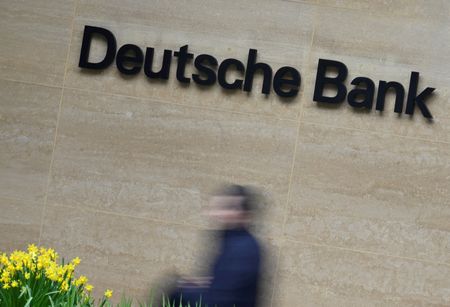
By Davide Barbuscia
NEW YORK (Reuters) – Some investors and analysts are calling for more coordinated interventions from central banks to restore financial stability, as they fear that tumult in the global banking sector will continue amid rising interest rates.
After the collapse of two U.S. lenders this month and last weekend’s Swiss-government-orchestrated takeover of troubled Credit Suisse markets have remained jittery. On Friday, shares of Deutsche Bank plunged amid concerns that regulators and central banks have yet to contain the worst shock to the banking sector since the 2008 global financial crisis.
Global central banks including the Federal Reserve have recently taken measures to enhance the provision of liquidity through the standing U.S. dollar swap line arrangements. At the same time, however, both the European Central Bank (ECB) and the Fed have continued to hike rates over the past two weeks, as they remain dead set on fighting stubbornly high price pressure.
For Erik Nielsen, group chief economics advisor at UniCredit in London, central banks should not separate monetary policy from financial stability at a time of heightened fears that banking woes could lead to a widespread financial crisis.
“Major central banks, including the Fed and the ECB, should make a joint statement that any further rate hike is off the table at least until stability has returned to the financial markets,” he said in a note on Sunday. “Statements like these within the next few days would most likely be needed to take us away from the brink of a much deeper crisis,” he said.
Money markets in the U.S. also expect the Fed to pause. Fed funds futures traders on Friday were pricing in only a 20% chance that the Fed will hike rates by an additional 25 basis points in May, and an 80% probability it will leave the rate unchanged at 4.75% to 5.0%. They also see the Fed cutting rates to 3.94% by December.
Others, however, think regulators will be able to ensure financial stability while continuing with their inflation-fighting campaign. “We see central banks sticking to a ‘separation principle’ – using balance sheets and other tools to ensure financial stability while keeping monetary policy focused on reining in inflation,” the BlackRock Investment Institute said in a note last week.
For now, few investors see this year’s events as a repeat of the systemic crisis that swept through markets in 2008, but they are wary that another bank run could erupt if people believe U.S. or European regulators won’t protect depositors.
“The situation remains fluid but we tend to think the way out of this problem could be coordinated central bank action to bolster confidence in the system,” said Felipe Villarroel, a partner and portfolio manager at TwentyFour Asset Management.
“The issue with European banks and big U.S. banks at the moment is confidence. It is not capital,” he said in a blog on Friday. “Consumers are nervous because they see banks failing and they question whether these issues will spread to other banks and whether or not they should take their deposits out or sell their bank stocks.”
U.S. regulators said last week the banking system remained ‘sound and resilient’ in a bid to calm markets and bank depositors. Treasury Secretary Janet Yellen on Thursday also said she was prepared to repeat actions taken in the Silicon Valley and Signature Bank failures to safeguard uninsured bank deposits if failures threatened more deposit runs.
Still, Fed data on Friday showed deposits at small U.S. banks dropped by a record amount following the collapse of Silicon Valley Bank on March 10.
Meanwhile, overall deposits in the banking sector have declined by almost $600 billion since the Fed began to raise interest rates last year, the biggest banking sector deposit outflow on record, noted Torsten Slok, chief economist at Apollo Global Management.
“The near-term risks to banks combined with uncertainty about deposit outflows, bank funding costs, asset price turbulence, and regulatory issues, all argue for tighter lending conditions and slower bank credit growth over the coming quarters,” he said.
(Reporting by Davide Barbuscia and Elisa Martinuzzi; Editing by Andrea Ricci)

